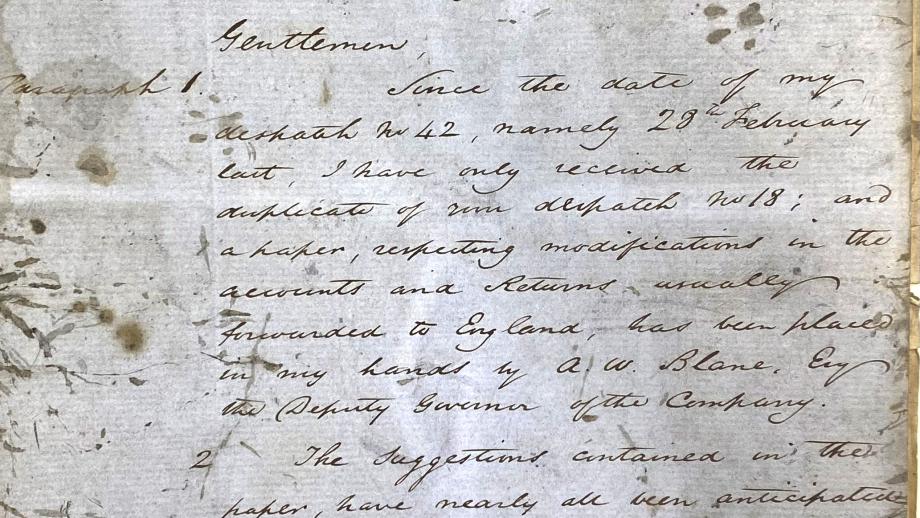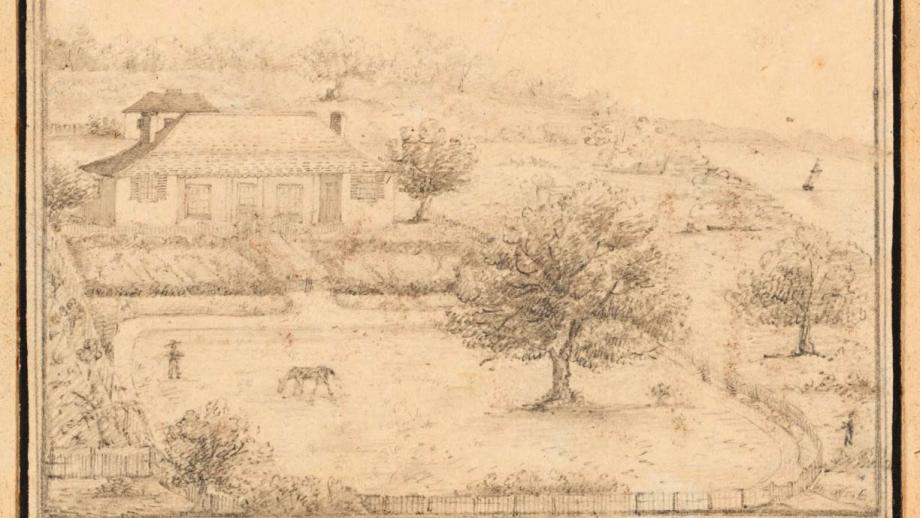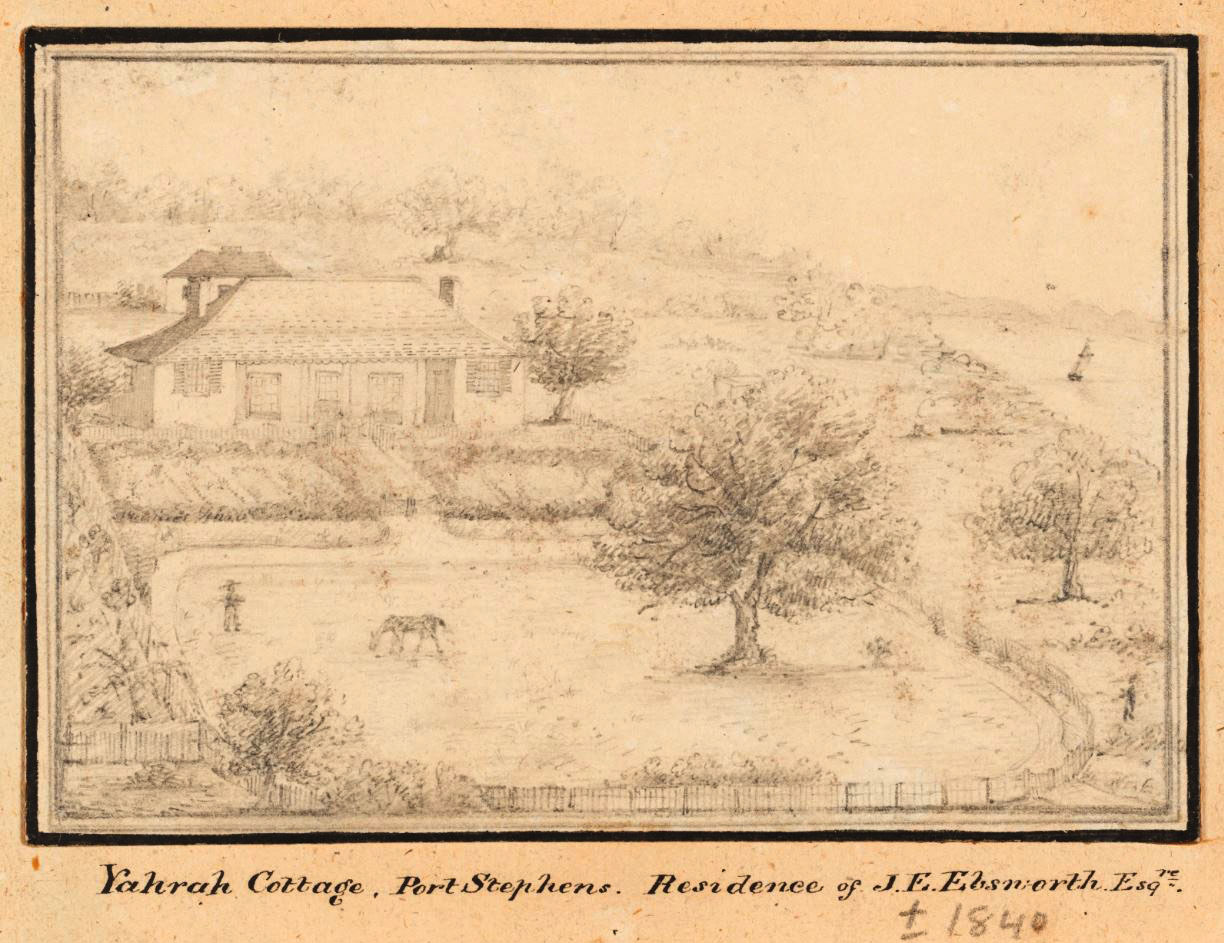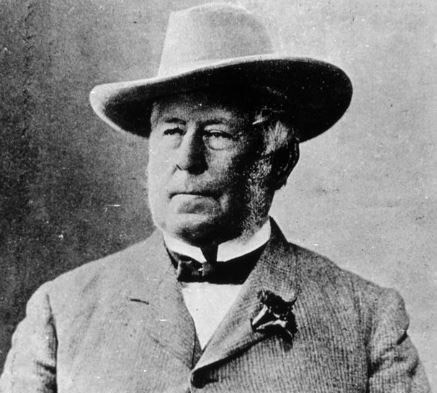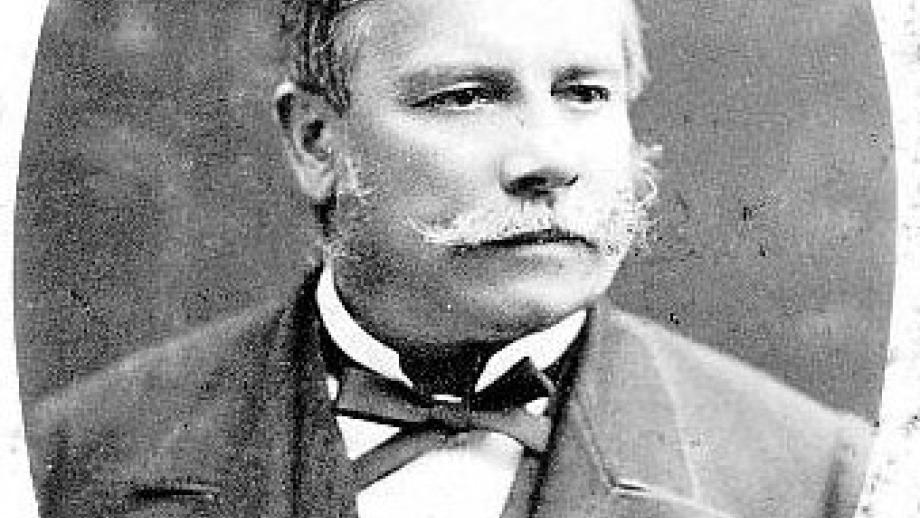Leaders of the 19th Century
Robert Dawson (Chief Agent, 1824-28)
The Australian Agricultural Company's first Chief Agent was Robert Dawson. Dawson was born in England in 1782 and was managing the Berkshire estate of Viscount Barrington when he was asked by John Macarthur Jnr, one of the Company's directors, to accept the role of Chief Agent of the newly formed Australian Agricultural Company.
Dawson oversaw the Company's operations in the Colony of New South Wales, under the watchful eye of a local committee comprising John Macarthur Jr’s brother James, his brother-in-law James Bowman and his cousin, Hannibal Hawkins Macarthur. Dawson was explicitly instructed to heed their advice on all occasions.
Dawson arrived in New South Wales in November 1825 with a group of 75 settlers and indentured servants, as well as almost 700 sheep, 12 cattle, and 7 horses.
Dawson was ultimately responsible for selecting the Port Stephens area for the establishment of the Company's first estate, having also been presented with options of land on the Liverpool Plains and the head of the Hastings River. Under considerable pressure to make a quick selection, Dawson opted to take the entire 1,000,000 acre grant at Port Stephens, a decision which would soon prove to be a mistake, with the Company's flock languishing on land there that was ill-suited to raising sheep.
Having clashed with the powerful Macarthurs about their tactic of offloading old and sick sheep from the colony to the Port Stephens Estate, in December 1827 Dawson was accused of mismanagement by James Macarthur and was suspended by the local committee in April 1828. In January 1829, on the recommendation of the local committee, the Company's Court of Directors formally dismissed him from his position as Chief Agent.
Following his dismissal, Dawson published a convincing rebuttal of the accusations levelled against him in his Statement of the Services of Mr Dawson, as Chief Agent of the Australian Agricultural Company. He returned to England late in 1828 and continued to press for justice, but a full hearing was never granted to him (Flowers, 2006).
Dawson continued his interest in Australia and published The Present State of Australia; a Description of the Country, its Advantages and Prospects with Reference to Emigration: and a Particular Account of its Aboriginal Inhabitants in 1830. He then returned to New South Wales in 1839, settling in the Upper Hunter region on his property 'Goorangoola', serving as a magistrate in the region.
Dawson returned to England in 1862 and died in Greenwich in 1866.
References
Flowers, E 2006, Robert Dawson (1782-1866), Australian Dictionary of Biography, National Centre of Biography, Australian National University, <https://adb.anu.edu.au/biography/dawson-robert-1969>
James Ebsworth (Interim Chief Agent 1828-30; Acting Commissioner 1849-51)
Following Robert Dawson’s dismissal as the Company’s Chief Agent, in December 1828 the Company appointed Englishman James Edward Ebsworth to serve as an Interim Chief Agent and manage the Company in New South Wales until a replacement could be sent from England. By this stage, the Company had over 17,000 sheep in the colony.
Ebsworth had arrived in Sydney on the ship Frederick in November 1827, along with approximately 30 passengers as well as 222 Merino sheep, 7 horses, and stores bound for the Company’s Port Stephens Estate. He had travelled to Australia to take up the role of Company Accountant at Port Stephens.
Dawson's brother Henry T. Ebsworth had travelled to Australia in 1825 to act as assistant to Chief Agent Robert Dawson.
With Dawson’s departure, James Ebsworth acted as Chief Agent until January 1830. It was not the only time he would act in this senior role, serving as Acting Commissioner (later known as General Superintendent) between 1849 and 1851.
Henry Dumaresq (1833-38)
Englishman Henry Dumaresq travelled to Australia in 1825 at the invitation of his brother-in-law General (Sir) Ralph Darling. Darling, who had been appointed Governor of New South Wales, invited Dumaresq to be his private secretary, with Dumaresq already serving as his secretary in Mauritius. Upon his arrival in Sydney, he was also appointed clerk to the Executive Council. Dumaresq had served in the Army, including at the Battle of Waterloo, where he was shot and badly injured.
Dumaresq and his brothers William and Edward, who had also immigrated to Australia, were often the subject of claims of nepotism under Darling’s governorship, with much written in the press of the favouritism shown to them, particularly with Henry and William having amassed substantial land holdings across New South Wales. Henry was granted 12,000 acres near Muswellbrook in New South Wales, which he named St Heliers. In 1835 he also claimed 100,000 acres for himself in the New England region of New South Wales.
Following Governor Darling’s departure from Australia, Dumaresq served as private secretary to his replacement, Acting Governor Patrick Lindesay, but retired from this position once Richard Bourke replaced Lindesay.
In 1833 Dumaresq accepted the position of Commissioner of the Australian Agricultural Company, taking over from Sir Edward Parry who had returned home to England. Dumaresq was serving in this position when he died suddenly after a short illness on 5 March 1838 at Tahlee House on the Company’s Port Stephens Estate. Dumaresq was buried on his property St Heliers and his brother William assumed the management of his land holdings.
Robert Marsh Westmacott (General Superintendent, 1851)
Captain Robert Marsh Westmacott arrived in Sydney from England in December 1831, having accompanied Governor Robert Bourke as his aide-de-camp.
Westmacott and his family settled in the New South Wales Illawarra district in the late 1830s and following his retirement from the Army, he was active in public life. He was appointed a justice of the peace, was elected trustee of the Illawarra Steam Packet Company, acted as the first secretary of the Illawarra District Agricultural Society and was steward at various race meetings in Wollongong and Sydney, where he raced his horses from time to time (Proudfoot 2011).
In 1840, Westmacott attempted to go into competition with his future employer, when he sought to open a coal mine in the Illawarra district, which was not part of the Australian Agricultural Company’s coal monopoly. This did not eventuate and the following year Westmacott was forced to declare bankruptcy and forego his estate to pay his creditors. Nevertheless, he stayed in the Illawarra region and surveyed a new road near Bulli in 1844 which became the Bulli Pass, and he became a commissioner of Crown lands in 1846 (Proudfoot 2011).
After attempts to secure employment in England were unsuccessful, Westmacott arrived in Sydney on 8 February 1851 to take up the newly created position of General Superintendent of the Australian Agricultural Company. Given his past attempt to open a rival coal mining operation, his appointment at the Company was curious and unpopular with many. Despite this, Westmacott took up the appointment.
Westmacott’s time with the Company was short-lived. In May 1851, his wife ran off with the captain of the Tartar, the ship that had brought the Westmacott family back to Australia just a few months prior, along with the Company’s Deputy Governor Archibald Blane. Westmacott hastily resigned after just a few months in the position and returned to England with his three youngest children. He was not to return to Australia, dying of inflammation of the stomach and exhaustion on 10 May 1870 (Proudfoot 2011).
Westmacott was a talented artist and some of his sketches and watercolours of New South Wales are held at the State Library of New South Wales and National Library of Australia.
References
Proudfoot, H 2011, Captain Robert Marsh Westmacott, Design & Art Australia Online, <https://www.daao.org.au/bio/version_history/captain-robert-marsh-westmacott/biography/>
Archibald William Blane (Acting General Superintendent, 1851-52)
Archibald Blane’s involvement with the Australian Agricultural Company began in England as an auditor and director for the Company before his election as Deputy Governor in 1845. It was in this capacity that he was asked to travel with the Company’s new General Superintendent Robert Westmacott to New South Wales, with Blane’s role being to assist him with settling in, to report on conditions, and to both facilitate the sale of land at Port Stephens and make it a commercial success.
Blane and the Westmacott family arrived in New South Wales on the ship Tartar in February 1851, but Westmacott’s tenure was short-lived. When Westmacott returned to England, Blane was asked to stay in Australia as the Company’s Acting General Superintendent (though always referred to as Deputy Governor) until Westmacott’s replacement arrived.
A year after Blane’s arrival, in February 1852, gold was discovered on the Company’s Peel Estate in Northern New South Wales, and he was kept occupied with arrangements for the supervision of the goldfields.
At the same time, the Company was experiencing significant issues with its Newcastle coal mines. Several of the Company’s senior employees were trading in coal in their own right, which Blane forbade, causing much trouble and resignations. The coal operations were also in flux with the Borehole Seam still to be fully proven.
Blane arranged the survey of the Company’s land at Newcastle and promoted the first sales there. He told his fellow directors that “many of the labouring gold diggers, and many settlers of respectability will be desirous to locate themselves on account of the salubrity of the neighbourhood of Newcastle and its convenient access to Sydney” [Despatch 32, 10 Jul 1852) (78/1/20, p581). The first auction was planned for 1 October 1852, however on the eve of the auction, Blane fell from a horse and lapsed into a coma, delaying the proceedings until April 1853.
Blane never recovered from his injuries and died at the age of 62 at Booral House on 6 November 1852. He was buried at Stroud on the Company’s Port Stephens Estate, although later exhumed at his widow’s request and reburied at Kensal Green Cemetery in London. The Company’s directors commissioned a marble plaque to honour Blane which was placed at St John’s Church in Stroud. The main street across the Company’s Newcastle Estate was also named Blane Street in his honour (later Hunter Street).
Marcus Freeman Brownrigg (General Superintendent, 1852-56)
Marcus Freeman Brownrigg was the second son of Major General Thomas Brownrigg and nephew of General Sir Robert Brownrigg, the latter being Military Secretary to the Duke of York and third British Governor of Ceylon (Sri Lanka). Naturally, Marcus’ path was to join the Royal Navy.
Brownrigg married Maria Blake, the daughter of a Navy Captain, at the Cape of Good Hope in 1829 and they spent their early married life in Cape Town and England before Brownrigg took up positions in Mauritius and Bombay (Mumbai) working as an agent for Cockerell & Co. The Brownrigg family, which included five children by then, returned to England where Marcus established a branch of Cockerell & Co in Liverpool, but the business failed and he accepted a new commission in the Royal Navy, based in Plymouth and then Glasgow, before deciding to apply for the position of General Superintendent of the Australian Agricultural Company, with his application possibly aided by the fact that his cousin John Studholme Brownrigg was the Company’s Chairman of Governors (Trumble 2017).
Brownrigg and his family arrived in Australia in November 1852 and took up residence at the Australian Agricultural Company’s Port Stephens Estate. Brownrigg was under enormous pressure. He arrived barely weeks after Blane’s death so there were no introductions. There was major confusion at the colliery and the need to expand markets. There was unhappiness at Port Stephens, where the Establishment was being dismantled. The formation of the Peel River Land and Mineral Company and the necessary division of the estate created enormous work. There was also an anxious desire to save money.
In 1856 Brownrigg was quite unfairly dismissed for incompetence and sued. However, there did appear to be some level of regret about his dismissal and in Newcastle “a public meeting of gentlemen was organised and a friendly address to Brownrigg was adopted by acclamation”, while in the press Brownrigg’s management of the Company was defended and many deplored “the loss of a gentleman at Port Stephens whose family had set such a conspicuous example of Christian piety”, with particular credit to Maria Brownrigg (Trumble 2017). These actions did not result in an extension of Brownrigg’s tenure, although the family initially stayed on at the Port Stephens Estate, taking up residence at Yarra Cottage in Carrington, while Arthur Hodgson was appointed as Brownrigg’s successor.
In 1859 the Brownriggs moved to the estate 'Glencoe' near Port Macquarie and Marcus was appointed police magistrate, a role he then took up in Albury before later settling in Tasmania.
References
Trumble, A 2017, Maria Caroline Brownrigg, National Portrait Gallery, <https://ftp.portrait.gov.au/aboutface/2017/11/maria-caroline-brownrigg>
Arthur Hodgson (General Superintendent, 1856-61)
Sir Arthur Hodgson was born in England in 1818. He arrived in Australia in 1839, leasing ‘Cashiobury’ in the New England district in New South Wales before moving to Queensland, where he settled at Eton Vale Station in the Darling Downs. Hodgson was amongst the Darling Down’s earliest European settlers, with Eton Vale just the second pastoral run established in Queensland. Despite early setbacks, Hodgson found success with sheep and wheat at Eton Vale and the property grew to include a homestead, workers’ cottages, outbuildings, and a school.
After serving in the New South Wales Legislative Assembly, Hodgson returned to England in February 1855. Recommended by W.S. Davidson, the Company’s largest shareholder, Hodgson was asked to replace Marcus Brownrigg, agreeing to work with a Board of Advice, and providing he could live in Sydney (the Company’s main office was located in Sydney between 1856-1861).
Hodgson oversaw the removal of sheep from Port Stephens, the development of Warrah, the introduction of new accounting arrangements and land sales at Newcastle and Port Stephens. Most of Warrah was still leased and Hodgson was very reluctant to commit the Company to a return to growing sheep for wool as the directors had hoped.
It was intended that the Colliery would be run by an experienced Viewer from England, but the first Viewer Robert Whytte was unsuccessful, and his successor J.B. Winship did not arrive until January 1861. With increasing labour trouble, Hodgson was instrumental in forming the first organisation of Colliery Proprietors (comprising the Australian Agricultural Company, The Newcastle Wallsend Coal Company, Newcastle Coal and Copper, and J & A Brown) in July 1861.
During this time, he was also elected to represent the seats of Darling Downs (1858) and Newcastle (1859) in parliament before moving into the Queensland Legislative Assembly after Queensland was proclaimed a state in 1859.
In 1870, Hodgson returned to England, although he retained an interest in Eton Vale and realised enormous profits from it, in no small part thanks to his two Scottish managing partners based there, John Watts and Robert Ramsay (Waterson 2006).
Hodgson died in England in 1902. A town near Roma and a farming district on the Darling Downs are named in his honour (Waterson 2006).
References
Waterson, DB 2006, Arthur Hodgson (1818-1902), Australian Dictionary of Biography, National Centre of Biography, Australian National University, <https://adb.anu.edu.au/biography/hodgson-sir-arthur-1155>
Edward Christopher Merewether (General Superintendent 1861-75)
Edward Christopher Merewether was born in London in 1820 and intended to take holy orders but instead created a very different life in Australia.
He arrived in Sydney in September 1841 and served as aide-de-camp to Governors Gipps and Fitzroy as well as Sir Maurice O’Connell before being appointed Commissioner for Crown Lands in the Lower Darling district of New South Wales in 1848. Merewether took up several government positions over the next decade or so, including Acting Chief Inspector of Distilleries and Clerk of the Executive Council.
In 1860 Merewether married Augusta Maria Mitchell, the daughter of physician and industrialist Dr James Mitchell. Mitchell was well-known to the Australian Agricultural Company, having established a rival coal mining operation in Newcastle in the 1840s and given evidence arguing against the Company’s coal monopoly at a government inquiry. Mitchell’s land, the Burwood Estate, adjoined the Company’s south boundary and “Dr Mitchell’s railway” (later the Newcastle Coal and Copper Company railway) cut across the Company’s land to the harbour.
In 1861 the Company offered Merewether the position of General Superintendent and he relocated to Newcastle, where he built his property ‘The Ridge’ on the Burwood Estate, which he and his wife had purchased from her father’s estate. Mrs Merewether’s brother, David Scott Mitchell, was the founder of the Mitchell Library in Sydney. Interestingly, as the owner of the Burwood Estate, Merewether had to negotiate with himself when the Australian Agricultural Company wanted to mine underneath it.
Merewether’s tenure with the Company was very successful and his management was seen as essential to restoring its good fortunes, particularly his management of the Company’s mining operations and development of the Warrah Estate on the Liverpool Plains.
Merewether was very much involved with the shifting allegiances between the Colliery owners on the Newcastle coalfields, including the formation of the Associated Northern Collieries (‘The Vend’) in 1872, and with the increasingly complex negotiation with the Miners’ Union – which included the agreement on a sliding scale of wages relative to the fluctuating price of coal.
During Merewether’s tenure there were significant improvements at Warrah. He had a sheep-washing pool and pump installed at a cost of over £4,000 and in 1868-1875 the run was subdivided with wire fencing for £13,500 (Smith 2006).
In February 1874 a group of shareholders insinuated Merewether’s administration of the Company's affairs was influenced by his private business interests (owning the Burwood Estate and leasing it to the Company) and in response to this he resigned (Smith 2006). However, Merewether was well-respected by the Company’s employees and was convinced to stay on by the Court of Directors, who presented him with £1,000. He eventually stepped down from his position on 31 December 1875.
Merewether was also a generous benefactor, financing the construction of St Augustine’s Church of England in the Newcastle suburb of Merewether (named in his honour) and giving funds to a variety of schools and schools of arts.
Merewether died at his home Castlefield, in the Sydney suburb of Bondi, in 1893, leaving an estate valued at £235,000 to his wife and nine children.
References
Smith, CE 2006, Edward Christopher Merewether (1820-1893), Australian Dictionary of Biography, National Centre of Biography, Australian National University, <https://adb.anu.edu.au/biography/merewether-edward-christopher-4188>
